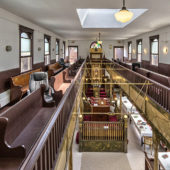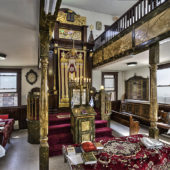Continuously operating since its dedication, Tifereth Israel is the oldest synagogue building in Queens.
Tifereth Israel is a wooden Gothic & Moorish Revival style synagogue built by Ashkenazi Jews who moved to Queens from Manhattan’s cramped Lower East Side. Since its 1911 dedication, the antique synagogue has been continuously used for Jewish worship.
Although Queens is the 4th largest city in the USA and New York’s second largest borough, it is often overlooked. There’s a knee-jerk reaction to think of Manhattan whenever the Big Apple is mentioned even though the population of Queens is 42% greater. There were Jews in Queens as early as 1759, yet their numbers were relatively small compared to Manhattan and Brooklyn due to those borough’s proximity to Ellis Island and seaports. When the synagogue was founded, an estimated 1.5 million Jews lived in New York City, yet only about 20,000 lived in Queens. If you have flown into either La Guardia or Kennedy airports, whether you’ve realized it or not, you’ve visited Queens. If you visited either the 1939 or the 1964-65 New York World’s Fairs, watched the Mets play at Citi Field, placed a bet at Aqueduct Racetrack, you were in Queens.
Designed by local architect Crescent L. Varrone, Tifereth Israel was modeled after synagogues on Manhattan’s Lower East Side which had to be sandwiched into narrow tenement lots. The wooden clapboard structure decorated modestly with Judaic ornamentations includes a multi-colored glass Star of David and arched windows. The second story is the women’s gallery while the basement, now a social hall, was used for classes including Hebrew lessons for Bar/Bat Mitzvah study. Later a mikvah was added and still later an unfortunate coating of stucco was slathered upon the wood siding. The stucco retained moisture causing wood rot only a termite could enjoy.
Over the decades, the demographics of the neighborhood changed. In the 1930s and 40s a wave of Italian immigrants moved into the area; then Hispanics; then Blacks; and now Spanish speaking Central Americans. Most of Queens’ Jews moved to Long Island in the 1970s and by the 1990s, the infrequently used synagogue was deteriorating as it suffered the twin blights of wood rot and demographic change. It was then that the heroes of this story, from the Uzbekistan cities of Samarkand and Bukhara, arrived.
The upbringing of Esther, the fair damsel of Samarkand, now rebbitzin of Corona, Queens, was entrusted to her stepmother. Who, if not a wicked stepmother, was at least callous as she placed the young Uzbek speaking future queen of Queens in a series of foster homes in Tajikistan where Tajik was the lingua franca. While Uzbek is written with the Latin alphabet, Tajik is written with Cyrillic as is Russian which the lass also learned since it is used as an inter-ethnic language in the “stans”. Once old enough to escape this linguistic and alphabetic morass, not to mention the tyranny of the foster homes, Esther immigrated to Israel to study art. There she learned Hebrew and English. That’s five languages and four alphabets. In 1980, Esther immigrated to New York to improve her English and further her art studies. Little more than a year after arriving on these shores, she met and was romanced by Rabbi Ammun Khaimov. They were soon married.
Ammun Khaimov’s grandfathers on both his father’s and mother’s side were rabbis. In 1932, one of his grandfathers was arrested by the Soviet authorities and died from torture on the 10th day of his arrest. Amnun’s other grandfather was arrested and exiled to Siberia during Stalin’s repression in 1938. He was tortured continuously – held naked in ice cold water and left with all of his teeth knocked out. Of course this had a strong impact on Ammun who resolved that he would continue their rabbinical work. He graduated from Yeshiva in Moscow, pursued post graduate studies in Budapest and served as a rabbi in Bukhara, Uzbekistan before colliding with Esther at a New York City wedding reception in 1995.
At the request of a group of Bukhari Jewish immigrants, Rabbi Ammun was instrumental in establishing the Lefrak City Jewish Center. Built by developer Sam Lefrak in the 1960s, Lefrak City is a huge campus of twenty 16-storey apartment buildings in the Corona section of Queens. It’s known as the stereotypical middle-working class housing development for those taking their first step up and out from the teeming tenements of Manhattan. To make the buildings particularly desirable to Jewish tenants the top floor of each building is designated the eighteenth (Chai, Hebrew for 18, also means life). How can the top floor of a 16-storey building be the 18th floor? It takes special Jewish mathematics: the lobby of each building is on the 2nd floor, followed by 16 floors of apartments with no 13th floor. Jewish ingenuity!
The Bukhari Lefrakians were looking for a leader – a rabbi who would revitalize the nearby dilapidated Tifereth Israel synagogue. Before the congregation could be rebuilt, the building had to be saved from a date with the wrecking ball. Indefatigable Esther sprang into action. She combed through city records to find the original 1911 architectural plans which were key to gaining landmark status in 2008. With its designation as a historic landmark, she was able to wrangle more than $1.6 million in grants from New York City, New York State Parks, Recreation and Historic Preservation, NY Landmarks Conservancy, Jewish Heritage Fund and the Estée Lauder Foundation. As a teenager, Estée Lauder, the cosmetics doyen, and her family attended the now ailing synagogue.
Thanks to two unlikely Uzbeks, Esther and Ammun, Tifereth Israel’s exterior has been restored following the original plans right down to the light blue paint color and gold trim. Inside, the heating and electrical have been replaced. Once again the congregation is slowly growing, providing a place of worship and communal focus for Orthodox Jews of nearby Lefrak City, Rego Park and Forest Hills.






